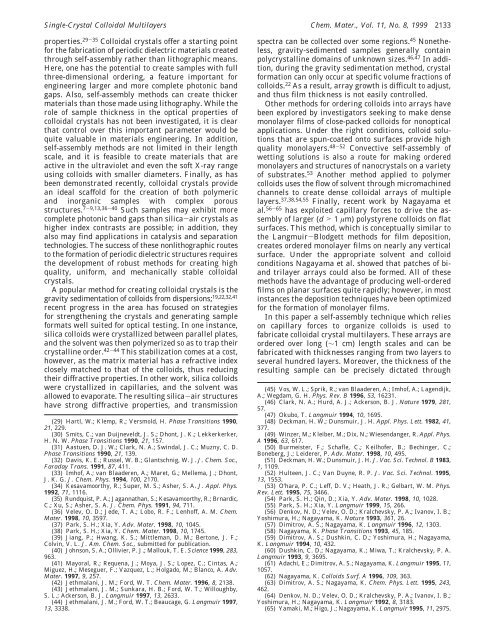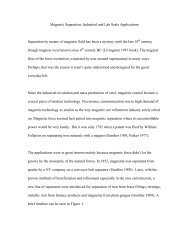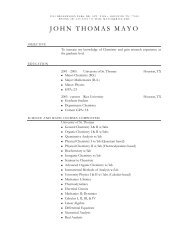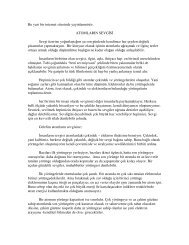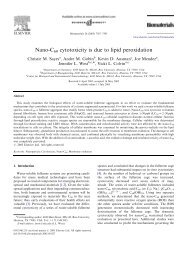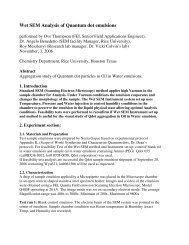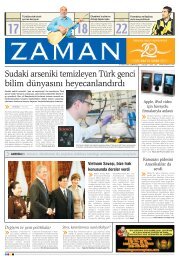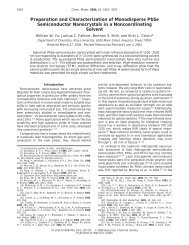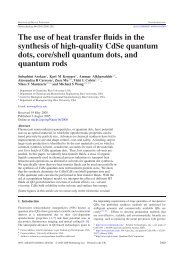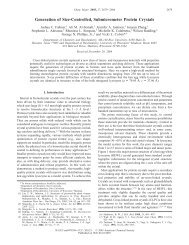Single-Crystal Colloidal Multilayers of Controlled Thickness
Single-Crystal Colloidal Multilayers of Controlled Thickness
Single-Crystal Colloidal Multilayers of Controlled Thickness
Create successful ePaper yourself
Turn your PDF publications into a flip-book with our unique Google optimized e-Paper software.
<strong>Single</strong>-<strong>Crystal</strong> <strong>Colloidal</strong> <strong>Multilayers</strong> Chem. Mater., Vol. 11, No. 8, 1999 2133<br />
properties. 29-35 <strong>Colloidal</strong> crystals <strong>of</strong>fer a starting point<br />
for the fabrication <strong>of</strong> periodic dielectric materials created<br />
through self-assembly rather than lithographic means.<br />
Here, one has the potential to create samples with full<br />
three-dimensional ordering, a feature important for<br />
engineering larger and more complete photonic band<br />
gaps. Also, self-assembly methods can create thicker<br />
materials than those made using lithography. While the<br />
role <strong>of</strong> sample thickness in the optical properties <strong>of</strong><br />
colloidal crystals has not been investigated, it is clear<br />
that control over this important parameter would be<br />
quite valuable in materials engineering. In addition,<br />
self-assembly methods are not limited in their length<br />
scale, and it is feasible to create materials that are<br />
active in the ultraviolet and even the s<strong>of</strong>t X-ray range<br />
using colloids with smaller diameters. Finally, as has<br />
been demonstrated recently, colloidal crystals provide<br />
an ideal scaffold for the creation <strong>of</strong> both polymeric<br />
and inorganic samples with complex porous<br />
structures. 7-9,13,36-40 Such samples may exhibit more<br />
complete photonic band gaps than silica-air crystals as<br />
higher index contrasts are possible; in addition, they<br />
also may find applications in catalysis and separation<br />
technologies. The success <strong>of</strong> these nonlithographic routes<br />
to the formation <strong>of</strong> periodic dielectric structures requires<br />
the development <strong>of</strong> robust methods for creating high<br />
quality, uniform, and mechanically stable colloidal<br />
crystals.<br />
A popular method for creating colloidal crystals is the<br />
gravity sedimentation <strong>of</strong> colloids from dispersions; 19,22,32,41<br />
recent progress in the area has focused on strategies<br />
for strengthening the crystals and generating sample<br />
formats well suited for optical testing. In one instance,<br />
silica colloids were crystallized between parallel plates,<br />
and the solvent was then polymerized so as to trap their<br />
crystalline order. 42-44 This stabilization comes at a cost,<br />
however, as the matrix material has a refractive index<br />
closely matched to that <strong>of</strong> the colloids, thus reducing<br />
their diffractive properties. In other work, silica colloids<br />
were crystallized in capillaries, and the solvent was<br />
allowed to evaporate. The resulting silica-air structures<br />
have strong diffractive properties, and transmission<br />
(29) Hartl, W.; Klemp, R.; Versmold, H. Phase Transitions 1990,<br />
21, 229.<br />
(30) Smits, C.; van Duijneveldt, J. S.; Dhont, J. K.; Lekkerkerker,<br />
H. N. W. Phase Transitions 1990, 21, 157.<br />
(31) Aastuen, D. J. W.; Clark, N. A.; Swindal, J. C.; Muzny, C. D.<br />
Phase Transitions 1990, 21, 139.<br />
(32) Davis, K. E.; Russel, W. B.; Glantschnig, W. J. J. Chem. Soc.,<br />
Faraday Trans. 1991, 87, 411.<br />
(33) Imh<strong>of</strong>, A.; van Blaaderen, A.; Maret, G.; Mellema, J.; Dhont,<br />
J. K. G. J. Chem. Phys. 1994, 100, 2170.<br />
(34) Kesavamoorthy, R.; Super, M. S.; Asher, S. A. J. Appl. Phys.<br />
1992, 71, 1116.<br />
(35) Rundquist, P. A.; Jagannathan, S.; Kesavamoorthy, R.; Brnardic,<br />
C.; Xu, S.; Asher, S. A. J. Chem. Phys. 1991, 94, 711.<br />
(36) Velev, O. D.; Jede, T. A.; Lobo, R. F.; Lenh<strong>of</strong>f, A. M. Chem.<br />
Mater. 1998, 10, 3597.<br />
(37) Park, S. H.; Xia, Y. Adv. Mater. 1998, 10, 1045.<br />
(38) Park, S. H.; Xia, Y. Chem. Mater. 1998, 10, 1745.<br />
(39) Jiang, P.; Hwang, K. S.; Mittleman, D. M.; Bertone, J. F.;<br />
Colvin, V. L. J. Am. Chem. Soc., submitted for publication.<br />
(40) Johnson, S. A.; Ollivier, P. J.; Mallouk, T. E. Science 1999, 283,<br />
963.<br />
(41) Mayoral, R.; Requena, J.; Moya, J. S.; Lopez, C.; Cintas, A.;<br />
Miguez, H.; Meseguer, F.; Vazquez, L.; Holgado, M.; Blanco, A. Adv.<br />
Mater. 1997, 9, 257.<br />
(42) Jethmalani, J. M.; Ford, W. T. Chem. Mater. 1996, 8, 2138.<br />
(43) Jethmalani, J. M.; Sunkara, H. B.; Ford, W. T.; Willoughby,<br />
S. L.; Ackerson, B. J. Langmuir 1997, 13, 2633.<br />
(44) Jethmalani, J. M.; Ford, W. T.; Beaucage, G. Langmuir 1997,<br />
13, 3338.<br />
spectra can be collected over some regions. 45 Nonetheless,<br />
gravity-sedimented samples generally contain<br />
polycrystalline domains <strong>of</strong> unknown sizes. 46,47 In addition,<br />
during the gravity sedimentation method, crystal<br />
formation can only occur at specific volume fractions <strong>of</strong><br />
colloids. 22 As a result, array growth is difficult to adjust,<br />
and thus film thickness is not easily controlled.<br />
Other methods for ordering colloids into arrays have<br />
been explored by investigators seeking to make dense<br />
monolayer films <strong>of</strong> close-packed colloids for nonoptical<br />
applications. Under the right conditions, colloid solutions<br />
that are spun-coated onto surfaces provide high<br />
quality monolayers. 48-52 Convective self-assembly <strong>of</strong><br />
wetting solutions is also a route for making ordered<br />
monolayers and structures <strong>of</strong> nanocrystals on a variety<br />
<strong>of</strong> substrates. 53 Another method applied to polymer<br />
colloids uses the flow <strong>of</strong> solvent through micromachined<br />
channels to create dense colloidal arrays <strong>of</strong> multiple<br />
layers. 37,38,54,55 Finally, recent work by Nagayama et<br />
al. 56-65 has exploited capillary forces to drive the assembly<br />
<strong>of</strong> larger (d > 1 µm) polystyrene colloids on flat<br />
surfaces. This method, which is conceptually similar to<br />
the Langmuir-Blodgett methods for film deposition,<br />
creates ordered monolayer films on nearly any vertical<br />
surface. Under the appropriate solvent and colloid<br />
conditions Nagayama et al. showed that patches <strong>of</strong> biand<br />
trilayer arrays could also be formed. All <strong>of</strong> these<br />
methods have the advantage <strong>of</strong> producing well-ordered<br />
films on planar surfaces quite rapidly; however, in most<br />
instances the deposition techniques have been optimized<br />
for the formation <strong>of</strong> monolayer films.<br />
In this paper a self-assembly technique which relies<br />
on capillary forces to organize colloids is used to<br />
fabricate colloidal crystal multilayers. These arrays are<br />
ordered over long (∼1 cm) length scales and can be<br />
fabricated with thicknesses ranging from two layers to<br />
several hundred layers. Moreover, the thickness <strong>of</strong> the<br />
resulting sample can be precisely dictated through<br />
(45) Vos, W. L.; Sprik, R.; van Blaaderen, A.; Imh<strong>of</strong>, A.; Lagendijk,<br />
A.; Wegdam, G. H. Phys. Rev. B 1996, 53, 16231.<br />
(46) Clark, N. A.; Hurd, A. J.; Ackerson, B. J. Nature 1979, 281,<br />
57.<br />
(47) Okubo, T. Langmuir 1994, 10, 1695.<br />
(48) Deckman, H. W.; Dunsmuir, J. H. Appl. Phys. Lett. 1982, 41,<br />
377.<br />
(49) Winzer, M.; Kleiber, M.; Dix, N.; Wiesendanger, R. Appl. Phys.<br />
A 1996, 63, 617.<br />
(50) Burmeister, F.; Schafle, C.; Keilh<strong>of</strong>er, B.; Bechinger, C.;<br />
Boneberg, J.; Leiderer, P. Adv. Mater. 1998, 10, 495.<br />
(51) Deckman, H. W.; Dunsmuir, J. H. J. Vac. Sci. Technol. B 1983,<br />
1, 1109.<br />
(52) Hulteen, J. C.; Van Duyne, R. P. J. Vac. Sci. Technol. 1995,<br />
13, 1553.<br />
(53) O’hara, P. C.; Leff, D. V.; Heath, J. R.; Gelbart, W. M. Phys.<br />
Rev. Lett. 1995, 75, 3466.<br />
(54) Park, S. H.; Qin, D.; Xia, Y. Adv. Mater. 1998, 10, 1028.<br />
(55) Park, S. H.; Xia, Y. Langmuir 1999, 15, 266.<br />
(56) Denkov, N. D.; Velev, O. D.; Kralchevsky, P. A.; Ivanov, I. B.;<br />
Yoshimura, H.; Nagayama, K. Nature 1993, 361, 26.<br />
(57) Dimitrov, A. S.; Nagayama, K. Langmuir 1996, 12, 1303.<br />
(58) Nagayama, K. Phase Transitions 1993, 45, 185.<br />
(59) Dimitrov, A. S.; Dushkin, C. D.; Yoshimura, H.; Nagayama,<br />
K. Langmuir 1994, 10, 432.<br />
(60) Dushkin, C. D.; Nagayama, K.; Miwa, T.; Kralchevsky, P. A.<br />
Langmuir 1993, 9, 3695.<br />
(61) Adachi, E.; Dimitrov, A. S.; Nagayama, K. Langmuir 1995, 11,<br />
1057.<br />
(62) Nagayama, K. Colloids Surf. A 1996, 109, 363.<br />
(63) Dimitrov, A. S.; Nagayama, K. Chem. Phys. Lett. 1995, 243,<br />
462.<br />
(64) Denkov, N. D.; Velev, O. D.; Kralchevsky, P. A.; Ivanov, I. B.;<br />
Yoshimura, H.; Nagayama, K. Langmuir 1992, 8, 3183.<br />
(65) Yamaki, M.; Higo, J.; Nagayama, K. Langmuir 1995, 11, 2975.


